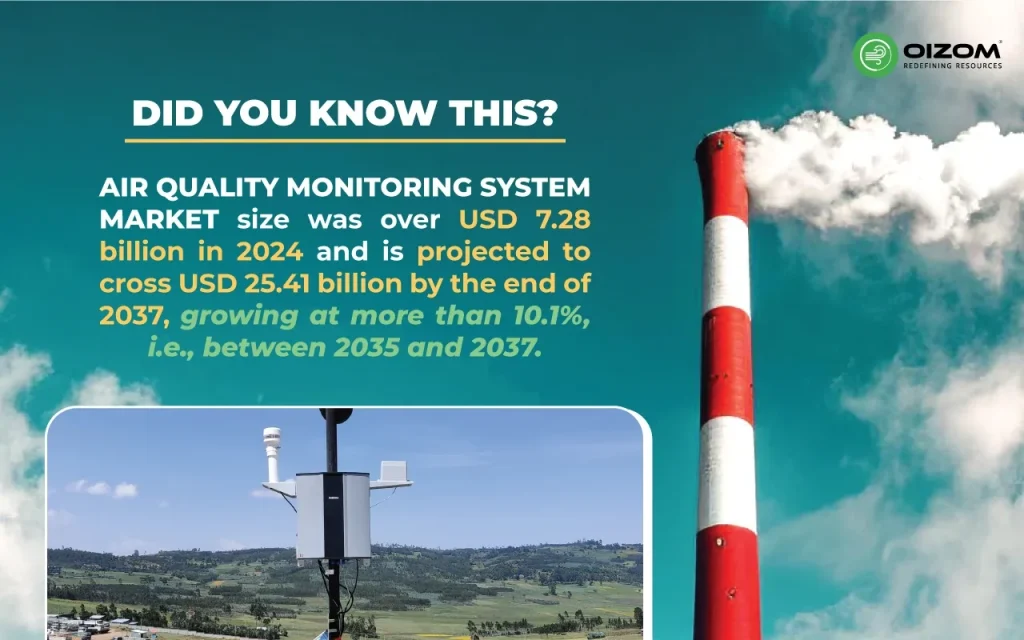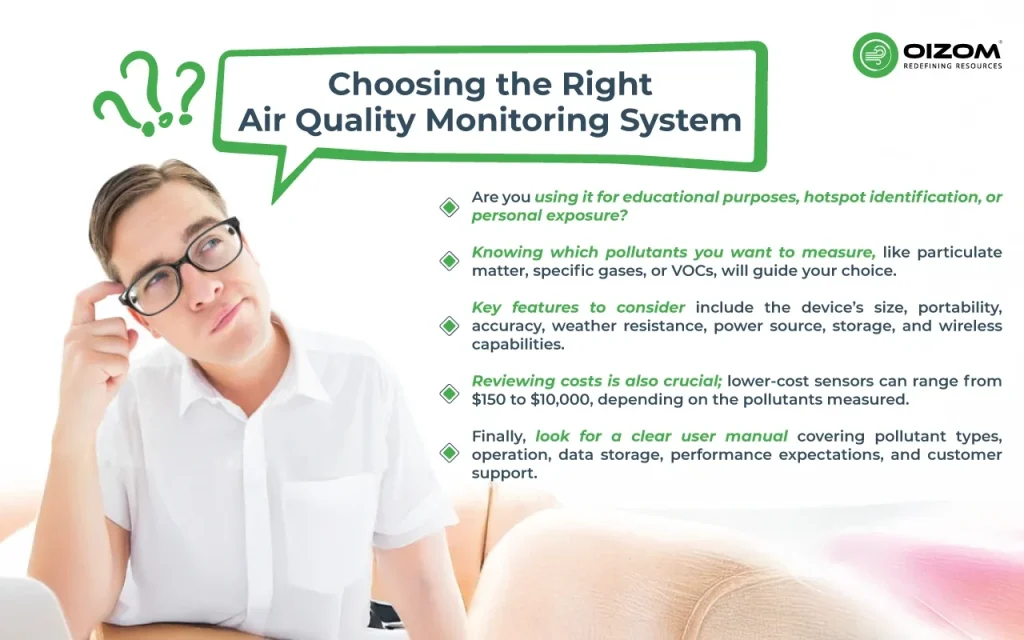10 key takeaway points:
- Impact of Air Quality: Air quality affects health, well-being, and the environment, making monitoring essential.
- Purpose-Driven Choice: Choose a monitor based on purpose, personal, community, industrial, or regulatory.
- Portable Monitors: These are compact, cost-effective, and ideal for on-the-go, flexible monitoring in multiple locations.
- Professional Monitors: Built for accuracy and reliability, they’re essential for industries and environments needing high-precision data.
- Data Flexibility: Portable monitors provide high spatial resolution by allowing “spot-by-spot” air quality assessments.
- Continuous Monitoring: Professional systems offer continuous, real-time data for accurate analysis and regulatory compliance.
- Cost and Maintenance: Portable monitors are budget-friendly with minimal maintenance, while professional monitors require higher investment and regular servicing.
- Applications: Portable monitors suit offices, schools, and other relevant places such as labs, mining, and construction, whereas professional monitors are best for industry, lab, and government monitoring.
- Data Quality and Reporting: Reliable data interpretation through platforms like Oizom’s Envizom enhances decision-making.
- Right Monitor, Better Environment: Choosing the right monitor enables better air quality management, benefiting individual health and communities.
Portable vs Professional Air Quality Monitoring: A Complete Comparison.
Are you concerned about the air you’re breathing? The quality of the air around you can greatly impact your health and well-being, whether at home, work, or elsewhere. Air pollution, with hazardous gases and dust, is present everywhere. These tiny, often invisible particles and gases circulate through our environment, impacting air quality, water purity, soil health, and human health. In our information-driven and technology-powered world, monitoring air quality has never been easier or more crucial. There are many different types of monitors on the market, some of which will meet your demands and others will not. While air quality monitors vary widely, they typically fall into a few categories that might help you in your search for an appropriate air quality monitor.
Portable air quality monitors and professional monitoring systems each play vital roles. Portable monitors are compact, easy to use, and perfect for on-the-go checks, making them a great fit for personal or quick assessments. Professional air quality monitors, however, offer unmatched precision and reliability and are designed for industries and environmental research where accuracy is paramount. By understanding the unique strengths of each, you can select the monitoring solution that best meets your air quality goals and contributes to a sustainable environment. In this blog, we’ll dive into an overview of portable and professional air quality monitors, exploring their key differences, applications, costs, and tips on choosing the right system for your needs.
Overview of portable air quality monitoring
Recent developments in air quality monitoring technologies present exciting possibilities for the future of air quality management. Traditionally, air quality has been monitored using fixed instruments placed in the same locations, collecting continuous data. While this method works, it requires multiple sites to get a complete picture of how air quality changes across an area. However, it has its limitations. In busy cities with heavy traffic, urban canyons, shifting weather, and Industrial emissions, air quality can vary a lot, and fixed networks may miss these changes.
In some cases, like quickly assessing a diesel emissions issue or checking the impact of a new policy, fixed stations may not provide the flexibility needed. Sometimes, existing networks have gaps or simply aren’t enough to give a full understanding. Also, there may be situations where a permanent monitoring station isn’t necessary or affordable. This is where portable monitoring comes in, offering a more detailed and adaptable view of air quality.
Portable air quality monitoring mechanism enable us to intensively characterize air quality rather than depending on permanent locations to provide a representative picture. Portable monitoring provides more opportunities to test air quality in a given area by employing portable sites that may be moved to multiple locations.

Overview of professional air quality monitoring
Professional air quality monitors are robust, highly accurate systems designed for environments that demand precise and reliable data. Unlike portable devices, these monitors are usually stationary and are equipped with advanced sensors capable of detecting a wide range of pollutants, including particulate matter, hazardous gases, and even environmental conditions like humidity and temperature. These monitors are built to meet the high standards required in industries, research labs, and government agencies, where decisions are based on highly detailed and continuous data.
What sets professional air quality monitors apart is their accuracy and ability to operate under diverse conditions. They provide continuous, real-time monitoring, allowing users to track trends, detect spikes in pollution, and respond to hazardous situations swiftly. Many professional systems integrate seamlessly with data management platforms, making it easier to analyze and report data over time.
Although professional monitors come with a higher price tag and require a skilled setup, they are indispensable for applications where accuracy and regulatory compliance are essential. Ideal for industries like manufacturing, construction, and urban planning, these systems empower organizations to monitor air quality rigorously, ensuring compliance and contributing to healthier communities. In essence, professional monitors are the go-to choice for those needing reliable, data-driven insights into air quality.
Key Differences Between Portable and Professional Air Quality Monitoring
There are various factors to consider when deciding between a portable air quality monitor and a professional air quality monitoring system. Understanding these distinctions is crucial for selecting a system that best meets your needs, whether for community, educational, or professional purposes.
In this blog, I’ll skip the traditional FRM and FEM technologies used for fixed-location air pollution measurement. Instead, I’ll focus on low-cost, sensor-based technology for ambient air quality monitoring and the role of portable air quality monitoring devices.
Portable and professional air quality monitors serve different needs, and understanding their key differences can help you pick the right tool.
- As opposed to stationary air quality monitors, including both FRM/FEM monitors and stationary low-cost sensors, portable air quality monitoring focuses on measuring air quality at multiple locations by moving the device to different spots as needed. Portable monitors are compact and versatile, allowing users to easily assess air quality across various environments without the need for a fixed installation. This approach provides flexibility and on-the-go insights, making it ideal for quick assessments in diverse settings, from offices to outdoor areas.
- One benefit of portable air quality monitoring is achieving high spatial resolution in measurements. By using a “spot-by-spot” approach to gather data across multiple locations, portable monitors can capture air quality readings in areas not typically covered by traditional FRM/FEM monitoring networks. This flexibility allows users to measure air quality at various sites, creating a more detailed picture of air quality in places where fixed monitoring stations may be absent. Additionally, They’re simple to set up and often come with app connectivity, providing immediate insights into air quality wherever you are.
- Professional air quality monitors, however, are designed for high accuracy and depth. These stationary systems use advanced sensors to capture a wide range of pollutants with precision, making them ideal for demanding environments like research labs, industrial sites, and government monitoring stations. With continuous, real-time tracking and integration with data systems, professional monitors help industries meet standards and respond quickly to pollution events.
- Stationary low-cost air quality sensors offer a middle ground between traditional, fixed monitors and portable devices in terms of both spatial and temporal resolution. This category is broad, with a range of sensor options available that vary significantly in performance, making it suitable for general air quality monitoring at a lower cost.
In summary, if you need flexibility and ease of use, a portable monitor is likely your best fit. However, if accuracy and data depth are priorities, especially in regulated or critical environments, professional-grade monitoring is the way to go.
Accuracy and Precision
When it comes to air quality monitoring, accuracy and precision are key. Accuracy ensures that a monitor’s readings reflect the true levels of pollutants, while precision means it can deliver consistent results over time. Portable monitors generally provide good accuracy for everyday awareness but may not match the high precision of professional-grade systems. Professional monitors are built for both high accuracy and precision, capturing detailed data that meets industry standards. Understanding these differences is important. Whether you need a general snapshot or reliable, consistent data, choosing the right monitor can make all the difference in air quality management.
Did you know Oizom has just launched its latest innovation, Pollusense? It’s a portable air quality monitor designed to provide accurate, real-time data on pollutants and environmental conditions. Equipped with advanced sensor technology, Pollusense uses laser-based, PID, MPS, and electrochemical sensors to detect particulate matter, gases like NO2, CH4, and VOCs, and even environmental factors like temperature, humidity, and pressure. This compact portable device is perfect for industries, environmental audits, or anyone needing flexible air quality monitoring on the go. With this Pollusense, you get accurate insights wherever you are, ensuring you always stay informed.
Cost and Maintenance
Cost and maintenance are important factors when choosing an air quality monitor. While safety should never be compromised, budgetary constraints are real. Balancing the necessity for accuracy, responsiveness, and other qualities against available funds might help to guide the decision. However, they always favor critical features over price.
- Portable air quality monitors provide an economical solution for air quality assessment, ensuring affordability without sacrificing key functionalities. By making air quality monitoring more accessible, these devices reduce the need for multiple fixed monitors, offering a flexible and budget-friendly alternative for comprehensive air quality management across multiple locations. However, they may need regular calibration to ensure accuracy.
- While more expensive, professional monitors offer superior precision and durability, especially suited for industrial and regulatory applications. These systems often require periodic servicing, calibration, and software updates to maintain peak performance. Balancing costs with maintenance needs can help you select the best solution, whether it’s a portable option for everyday insights or a professional-grade monitor for long-term, reliable data.
Application and Usage
When it comes to monitoring air quality, integrating portable air monitoring techniques with traditional fixed stations is an effective approach. By combining portable air quality monitoring with existing fixed sites, we acquire a more comprehensive and spatially representative understanding of air quality, allowing for better decision-making.
- Air quality monitors have varied applications based on their type. Portable monitors are perfect for on-the-go checks, helping small businesses, EHS, Industries, and researchers gather quick, localized data in different environments. They’re commonly used in offices, schools, mining, construction, and outdoor areas where flexibility is key.
- Professional monitors, on the other hand, are built for industrial, regulatory, and research purposes, providing precise data over extended periods. These high-grade monitors are ideal for settings like factories, laboratories, and urban monitoring stations, where accuracy and compliance are critical. Choosing the right type depends on whether you need mobility or long-term, in-depth analysis. iscing elit. Ut elit tellus, luctus nec ullamcorper mattis, pulvinar dapibus leo.
Data Quality and Reporting
Oizom Pollusense and other devices are designed to provide users with a seamless, reliable air quality monitoring experience, no matter the environment. Whether in industries, mining, or construction sites, Pollusense delivers accurate data continuously, undeterred by harsh conditions.
Paired with Oizom’s Envizom, an advanced air quality visualization and analytics platform, users can access real-time data and insights. Powered by AI and Machine Learning, Envizom ensures precise data interpretation, enabling users to make informed decisions quickly and effectively.
Choosing the Right Air Quality Monitoring System

When choosing the right air quality monitoring system, it’s essential to consider a few key questions. Start by identifying your purpose: Are you using it for educational purposes, hotspot identification, or personal exposure? Knowing which pollutants you want to measure, like particulate matter, specific gases, or VOCs, will guide your choice. Key features to consider include the device’s size, portability, accuracy, weather resistance, power source, storage, and wireless capabilities.
Check the device’s performance periodically and compare it to a nearby regulatory monitor. Reviewing costs is also crucial; lower-cost sensors can range from $150 to $10,000, depending on the pollutants measured. Finally, look for a clear user manual covering pollutant types, operation, data storage, performance expectations, and customer support. With these factors in mind, you’ll be well-equipped to select a monitor that meets your air quality monitoring needs.
Conclusion
In today’s world, monitoring air quality has become more accessible than ever, thanks to advancements in both portable and professional air quality monitoring devices. Selecting the right system depends on your specific needs, whether you want quick, flexible measurements or detailed, precise data over time. Portable monitors offer convenience and flexibility, ideal for those looking to track air quality in various locations. Professional monitors, while more of an investment, provide the high accuracy needed for regulatory compliance and in-depth analysis.
As you decide, consider factors like the pollutants you need to monitor, budget, and maintenance requirements. Regular checks and comparisons with regulatory standards will also help ensure your device provides reliable data. Ultimately, choosing the right air quality monitor is a step toward better understanding and managing the air you breathe. With the right device, you’re equipped to make informed decisions that contribute to healthier environments for yourself and your community.






